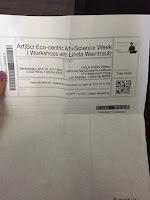Extra Credit Event 1: Fowler Museum
 |
| Image of me in front of the start of the Exhibition |
For the extra credit assignment, I went to the Fowler to see the exhibition called African-Print Fashion Now! This exhibition looks at African print cloth that is known for its “colorful, boldly designed, manufactured cotton textiles” (Fowler). These textiles are shown in a traditional fashion where the exhibition tells the story of these textiles throughout history in both African and around the world. The history of the African print cloth coming to Africa started during the colonial era in Indonesia where the Dutch and the English saw an opportunity to mass produce this fabric and bring it back to their home countries. On the way back from Indonesia, the boats would have to stop in West Africa causing the West African people to see these fabrics and take an interest in it. The Dutch and English material failed in Indonesia making them bring the design to Africa instead knowing that it would be successful there and they were right because the design flourished (Mazuri).
 |
|
IPads featuring images of portraits of African Women in African Print cloth
|
While reading the introduction to the exhibition, one statement that caught my eye was that “the world of African-print fashion encompasses narratives of self-expression, stories of family and history, and images of cutting edge global chic” (Exhibition intro). I found that this sentence perfectly portrays the ideas of each piece because every one of them seemed to have a connection to a personal story. The exhibition is split into four sections, and one section that caught my interest was the section called “Portraits in Print.” In this section, there was a group of IPads hanging from the wall that changes pictures every couple of seconds to show portraits of multiple different African women wearing all types of African print styles (Connors). I found this interesting because it combined aspects we learned in class about technology and art like using an art form that has been around for 100 of years that is being viewed through a new type of technology interactively.
 |
|
Oubliez le passé et Vous Perez Les Deux Yeux by Eddy Kamuanga Illunga
|
At the end of the exhibition, there is a clear area that visualizes the future of African print-cloth, which can be seen in the art piece by Eddy Kamuanga Illunga called Oubliez le passé et Vous Perez Les Deux Yeux (Forget the Past and Lose Both Eyes). This piece shows the theme of globalism and how he references that globalism is causing a strain in the tradition of African prints (Stromberg). I thoroughly enjoyed my experience in this exhibition and felt that anyone could enjoy it because it was visually appealing.
References:
Connors, Erin. "Colorful African-print Fashions Coming to the Fowler Museum at UCLA." UCLA Newsroom. N.p., 14 Mar. 2017. Web. 07 June 2017. <http://newsroom.ucla.edu/releases/african-print-fashion-now-a-story-of-taste-globalization-and-style>.
"Exhibitions." Fowler Museum. N.p., n.d. Web. 07 June 2017. <http://www.fowler.ucla.edu/exhibitions/african-print-fashion-now/>.
"A History of African Wax Prints." Mazuri Designs. N.p., 4 Feb. 2016. Web. 07 June 2017. <http://mazuridesigns.com/blog/2016/2/4/a-history-of-african-wax-prints>.
Illunga, Eddy Kamuanga. Oubliez le passé et vous perdez les deux yeux.(Forget the Past and Lose Both Eyes). 2016. African-Print Fashion Now, The Fowler, Los Angeles.
Stromberg, Matt. "The Global History of African Textiles at the Fowler Museum." Hyperallergic. Hyperallergic, 24 Mar. 2017. Web. 07 June 2017. <https://hyperallergic.com/367727/the-global-history-of-african-textiles-at-the-fowler-museum/>.
Wall text for “Exhibition Introduction.” African-Print Fashion Now. 26 March. 2017-July.30, The Fowler, Los Angeles.



Comments
Post a Comment